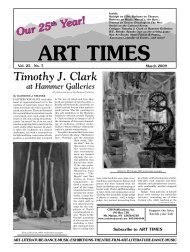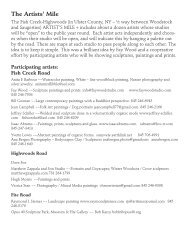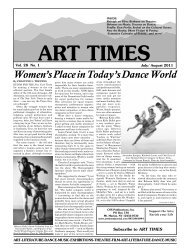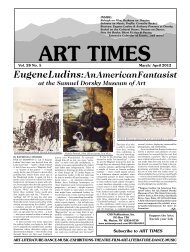Review: Drawings from the Louvre at The Morgan - Art Times
Review: Drawings from the Louvre at The Morgan - Art Times
Review: Drawings from the Louvre at The Morgan - Art Times
You also want an ePaper? Increase the reach of your titles
YUMPU automatically turns print PDFs into web optimized ePapers that Google loves.
Travel and Culture<br />
By CORNELIA SECKEL<br />
THE MEMBERS OF <strong>the</strong> Woodstock<br />
<strong>Art</strong>s Fair’s workers and volunteers<br />
were invited by one of our members to<br />
join her in Puerto Rico after <strong>the</strong> Fair.<br />
<strong>The</strong>re were 6 of us and it was wonderful.<br />
Christopher Columbus landed<br />
on <strong>the</strong> island of Puerto Rico in 1493<br />
on his second voyage of discovery,<br />
and originally named it San Juan<br />
Bautista in honor of Saint John<br />
<strong>the</strong> Baptist. <strong>The</strong> name of <strong>the</strong> island’s<br />
present day capital, San Juan, honors<br />
<strong>the</strong> name Columbus first gave<br />
<strong>the</strong> island. In 1508, it was settled<br />
Hand carved mask often used in ceremonies<br />
by explorer Ponce de Leon and <strong>the</strong><br />
island stayed under Spanish possession<br />
for over four centuries until 1898<br />
when it became a commonwealth<br />
of <strong>the</strong> United St<strong>at</strong>es. Today <strong>the</strong>re<br />
is a blending of cultures including<br />
<strong>the</strong> ancient Taíno people th<strong>at</strong> were<br />
exploited/ eradic<strong>at</strong>ed (although with<br />
DNA testing many Puerto Ricans are<br />
reconnecting with <strong>the</strong>ir roots), <strong>the</strong><br />
Africans who were brought <strong>the</strong>re<br />
as slaves, and peoples <strong>from</strong> Spain,<br />
France, Cuba, Lebanese and Do-<br />
minican. Puerto Rico is a combin<strong>at</strong>ion<br />
of all <strong>the</strong>se cultures and has a<br />
distinct L<strong>at</strong>in temperament. Often<br />
when I would question something my<br />
friend would tell me “this is Puerto<br />
Rico, <strong>the</strong>re is a different time sense<br />
here”. We stayed in Isabela, loc<strong>at</strong>ed<br />
in <strong>the</strong> north-western region of <strong>the</strong> island<br />
where <strong>the</strong> annual precipit<strong>at</strong>ion<br />
is around 62.8 inches, and average<br />
temper<strong>at</strong>ure is 84.7°F. (ask me if<br />
I’m ready to return). For most of our<br />
time we walked <strong>the</strong> beach, <strong>at</strong>e typical<br />
Puerto Rican food, did some shopping<br />
and exploring. One day several of<br />
<strong>the</strong> women happened<br />
upon Aguadilla and<br />
we understood th<strong>at</strong> it<br />
was a c<strong>at</strong>holic holiday<br />
(beginning of Advent<br />
perhaps) and festivities<br />
included Santa coming<br />
to town and a truck<br />
th<strong>at</strong> had a snow making<br />
machine shooting<br />
snow out amongst <strong>the</strong><br />
thousands of people<br />
th<strong>at</strong> lined <strong>the</strong> streets.<br />
<strong>The</strong>y had a gre<strong>at</strong> time<br />
and were tre<strong>at</strong>ed to local<br />
culture<br />
Though <strong>the</strong>re are<br />
numerous galleries<br />
throughout <strong>the</strong> island,<br />
I visited just a few.<br />
<strong>The</strong> Gaba Gallery in<br />
Aguarda is owned by<br />
artist Nayda Bonet.<br />
She has many paintings,<br />
sculptures and<br />
jewelry <strong>from</strong> local artists.<br />
Myra, our hostess<br />
in Puerto Rico and my<br />
co-chair of <strong>the</strong> Woodstock<br />
<strong>Art</strong>s Fair, is a<br />
sculptor and painter. She brought<br />
one of her paintings “Las Brisas del<br />
Secreto” to have framed and Nayda<br />
asked if she could have it to sell <strong>at</strong> <strong>the</strong><br />
gallery. Nayda has a small coffee bar<br />
and Thursday evenings she has Jazz<br />
musicians performing. Myra’s friend<br />
Deborah’s apartment is a gallery<br />
unto itself. She had several paintings<br />
by Wichie Torres whose landscapes<br />
and cityscapes and portraits of indigenous<br />
people are powerful with<br />
bold colors and strong brush strokes.<br />
Myra Schwartz and Nayda Bonet with Myra's painting “Las Brisas del Secreto”<br />
Puerto Rico<br />
Ano<strong>the</strong>r painter whom we all seemed<br />
to like is Movra whose work is reminiscent<br />
of <strong>the</strong> social realists here in<br />
<strong>the</strong> st<strong>at</strong>es. O<strong>the</strong>r predominant artwork<br />
includes masks (many worn <strong>at</strong><br />
certain festivals), santos (usually a<br />
carving of a saint on wood also used<br />
for religious purposes), prints, and<br />
jewelry.<br />
An important art<br />
museum in Puerto Rico<br />
is <strong>the</strong> N<strong>at</strong>ional Gallery,<br />
loc<strong>at</strong>ed in San<br />
Juan in an old Dominican<br />
Convent<br />
th<strong>at</strong> was built in <strong>the</strong><br />
16th century and contains<br />
a gallery of paintings<br />
<strong>from</strong> Puerto Rican<br />
masters such as Jose<br />
Campeche y Francisco<br />
Oller. Additionally<br />
<strong>the</strong>re are a number<br />
of rooms of paintings<br />
and o<strong>the</strong>r works of art<br />
(paintings and decor<strong>at</strong>ive)<br />
<strong>from</strong> Puerto<br />
Rican artisans of <strong>the</strong><br />
18th – 20th centuries.<br />
As I understand it, serious<br />
students of Puerto<br />
Rican art go to <strong>the</strong><br />
Institute of Puerto<br />
Rican Culture in <strong>the</strong><br />
Dominican Convent in<br />
Old San Juan. It’s <strong>the</strong><br />
best source of inform<strong>at</strong>ion<br />
on <strong>the</strong> island about Puerto Rican<br />
arts and crafts.<br />
Also in San Juan is <strong>the</strong> Museum<br />
of <strong>the</strong> Americas housing a number of<br />
exhibits, some permanent, and some<br />
temporary all with <strong>the</strong> focus to bring<br />
about understanding of <strong>the</strong> history<br />
and culture of <strong>the</strong> Americas. It covers<br />
art <strong>from</strong> <strong>the</strong> pre-Columbian era to<br />
<strong>the</strong> present and a variety of artists<br />
<strong>from</strong> L<strong>at</strong>in America, <strong>the</strong> United<br />
St<strong>at</strong>es and Puerto Rico are showcased<br />
<strong>at</strong> <strong>the</strong> Museum. <strong>The</strong> Museo de<br />
<strong>Art</strong>e de Ponce opened its doors on<br />
January 3, 1959, in a colonial house<br />
in <strong>the</strong> heart of Ponce, <strong>the</strong> second<br />
largest city in Puerto Rico. <strong>The</strong> first<br />
works in <strong>the</strong> museum’s collection<br />
were acquired in 1957, when Luis<br />
A. Ferré, a successful businessman,<br />
Jan/ Feb 2012 ART TIMES page 5<br />
Woodstock <strong>Art</strong>s Fair Committee members in Puerto Rico. (L to R) Ann Silverman,<br />
Cornelia Seckel, Myra Schwartz, Ruth Beyl, Betsy Oden, Elaine Jaffe<br />
philanthropist, and future governor<br />
of Puerto Rico, purchased 24 paintings<br />
<strong>at</strong> auction in So<strong>the</strong>by’s in New<br />
York City. Thirteen of <strong>the</strong>se are still<br />
part of <strong>the</strong> museum’s collection th<strong>at</strong><br />
now has over 4,500 works of art <strong>from</strong><br />
many cultures d<strong>at</strong>ing <strong>from</strong> <strong>the</strong> 9 th<br />
century to <strong>the</strong> present. Nineteenth-<br />
Painting by Puerto Rican artist Wichie Torres<br />
century English painting and seventeenth-century<br />
Baroque painting<br />
are <strong>the</strong> 2 strongest collections in <strong>the</strong><br />
museum. <strong>The</strong> Anton J. Konrad<br />
Conserv<strong>at</strong>ion Center, founded in<br />
1979 by Anton J. Konrad is part of<br />
<strong>the</strong> museum complex. It was <strong>the</strong> first<br />
labor<strong>at</strong>ory for <strong>the</strong> conserv<strong>at</strong>ion of art<br />
works to be established in Puerto<br />
Rico, and its dual mission has been to<br />
conserve and protect <strong>the</strong> collections of<br />
<strong>the</strong> Museo de <strong>Art</strong>e de Ponce and to offer<br />
professional services to museums,<br />
historical societies, cultural institutions,<br />
priv<strong>at</strong>e collectors, and local and<br />
intern<strong>at</strong>ional artists.<br />
I expect to travel again to Puerto<br />
Rico, and this time to visit with individual<br />
artists.<br />
ef











